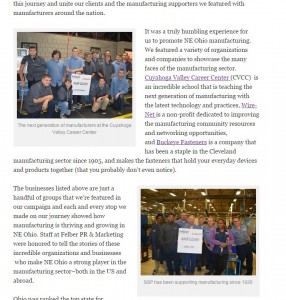
Trade Shows for Manufacturers – Maximize the Three Most Important Stages
- Pre-show: Picking your best tactics
- During the show: The floor show rules
- Post-show: Don’t squander your investment
Goal Setting:
Before you begin, you must know your main goal. Do you really know what you want to happen at this show?
Here are some additional questions you should brainstorm with your team:
- Can you expect actual sales and signed purchase agreements?
- Is your goal to introduce a product line for the first time?
- Perhaps the goal is setting appointments or simply improving customer relationships.
- Are you there to negotiate with other vendors?
Do not forget about those that speak to the masses; media relationships can help promote your company for months or years!
Marketing 101: Consider first who you want to hear, see, feel and understand your message, then set your goals accordingly.
Pre-Show Tactics
Before you do anything, secure the show handbook – and read it! All rules, equipment order forms, press conference room reservations and sponsorship opportunities will be contained in this exhibitor kit. Pay attention to deadlines and order materials on time so you do not incur unnecessary fees.
Theme
First, establish a theme for your show or series of shows. Your theme should be relevant to your goals. Also, consider is this a one-time theme or a motif you will carry across multiple shows. Using a theme for a longer period allows you to amortize costs associated with a show. For example, printing materials for multiple shows or building show graphics that can be used throughout a series of events. Does your theme pass the culture test? Check for slang, understandable industry terms, and recognition by attendees.
Advertising

An advertisement we created for our client for the Fastener Tech trade show.
Are you purchasing advertising in a show program, association journal or other publication? Graphics used with the tactic of reinforcing messages and driving booth traffic should match your booth graphics and show literature.
Consistency is KEY for brand recognition! Research the following: Trade publications with bonus coverage and show coverage, show dailies (publication just printed for the show), online, text and social media messages. All of these are advertising avenues to consider when building your pre-show plan.
Publicity
For you to be successfully published, the most important factor is newsworthiness. Does your story resonates with the publication’s readers? If you cannot interest an editor from a reader’s perspective then you do NOT have a story!
- Check with show management and see if they will release a list of pre-registered media attendees. These are credentialed media that will be at the show – looking for you and your news
- Schedule interviews and media relationship building appointments in advance
- Schedule press conferences: Are you making a newsworthy announcement? Press conferences may be in special rooms, booked in advance or simply conducted at your booth. If at your booth, do you need audio to carry above the show din?
- All shows have press rooms, touch down locations for the media to work quietly. You are almost always allowed to place company literature and press kits in these rooms. Prepare media kits that tell your story and have everything ready before they arrive
- Can you be a speaker or panelist at the show? Often these positions are filled a year in advance so plan ahead and take the stage as an industry expert
Booth Traffic
You are opening your “store” on the show floor. It’s critical that people know you are open for business.

Booth design- National Business Aviation Association (NBAA) show
- Determined your best, qualified prospect. Is it an owner, purchasing manager or perhaps a whole buying team?
- Consider two-part promotions where your prospect needs to visit the booth to get the second part of a promotion (activation code, show special, after-hours invite, etc.)
- Can you purchase or obtain a pre-registered attendee list?
- Don’t just have a prize drawing just for the sake of warm bodies in your booth – qualify and target the attendees that you want on your carpet.
- Training – it is CRITICAL that all booth staff know the promotion along with the overall goals and theme for the show.
During the Show
Entertainment – what else can you do to build relationships with your prospects and customers? Consider inviting prospects to a private hospitality suite. Make sure to coordinate special meetings around other show sponsored events such a major keynotes, annual meetings and other parties so as not to conflict with your event. The off-show hours are also a time to have private lunches and dinners with customers. Make sure to book appoints in advance and have transportation/reservations booked.
Booth personnel – The people in the booth are your brand’s spokespeople. They are the ones who will give tradeshow attendees a first impression of your business, so select booth personnel wisely! A combination of sales and technical people works well. Staff should be fully briefed on all themes, promotions, lead capture procedures and how to best interact with guests and the media. Make sure to staff properly especially during busy periods and when other staff members have scheduled customer/media meetings in the booth. When a guest walks into your booth, they should know who is working for your company and who is visiting. Coordinated apparel ensures clear staff identification and enhances branding.
Key Points for Booth
- Location, location, location! Some shows require advance bidding for space. Get the best location relative to main floor traffic patterns. Note locations of main stage events and, yes, the bar
- Your booth should have an open, friendly layout. No one wants to have to jump over a table facing the aisle where two uninterested staff members are sitting down, talking on their phone (we see this EVERY show)
- Layout your booth to accommodate private or semi-private meetings. Having a private, closed door section of the booth makes for a nice location for media and customer meetings
- Can you secure an island booth with traffic aisles on all four sides? Make the best use of booth graphics so all directions of traffic have a view of your theme, message and product information
- Consider sponsorship of the show or special events at the show. Can you use floor graphics or other signage to improve your presence? What about sponsoring a cocktail party or maybe just the attendee lanyards? There are countless opportunities to show off your brand
Qualify leads – Remember your purpose at the show. All messages, promotions and advertising should be leading prospects down a path. The better you qualify the leads, the more you will maximize your investment. Consider whether you need to purchase lead capture equipment to easily scan prospects information during their visit.

Post-show direct mailing integrating lead capture data with printed luggage tag keepsake
Post Show
Measurement. What did you want to happen? Did it work? Let’s face it, most companies do not follow up after shows. They never put a plan in place to use the valuable leads they capture. If you do not follow up in 3-7 days, you will be forgotten!
- Have prepared thank you emails ready to be sent to the captured leads. Graphics should match pre and during show promotion
- Consider mailing a unique package to prospect, complete with the specific information discussed/requested during the show
- Purchase or obtain attendee lists and scour for additional leads
Next Year’s Show
One of the best ways to maximize budget is to commit to next year’s show during this year’s event. Often there are deals to be had and better locations to be secured. Show owners are eager to get a jump start on their next trade show. Now is the time to negotiate and secure your best deal.
Need help? We’ve been there and have worked with countless manufacturers, just like you!
Call Rob Felber (330) 963-3664 x1 or RobFelber@felberpr.com for your free 45 minute consultation.We can talk through your show schedule, booth ideas, promotion….anything you want to discuss about trade shows.
More information at these blog posts:
7 Tips for Ultimate Trade Show Success: http://www.felberpr.com/7-tips-for-ultimate-trade-show-success/
Trade Show Preparation 101 for Manufacturers http://www.felberpr.com/trade-show-preparation-101-for-manufacturers/















 alendars, October 2nd is a worldwide celebration of manufacturing! MFG (Manufacturing) DAY addresses common misperceptions about manufacturing, “giving manufacturers the opportunity to open their doors and show, in a coordinated effort, what manufacturing is — and what it isn’t.” MFG DAY encourages manufacturers to work together to address and find solutions to their collective challenges; helping future generations and their communities thrive.
alendars, October 2nd is a worldwide celebration of manufacturing! MFG (Manufacturing) DAY addresses common misperceptions about manufacturing, “giving manufacturers the opportunity to open their doors and show, in a coordinated effort, what manufacturing is — and what it isn’t.” MFG DAY encourages manufacturers to work together to address and find solutions to their collective challenges; helping future generations and their communities thrive. 



